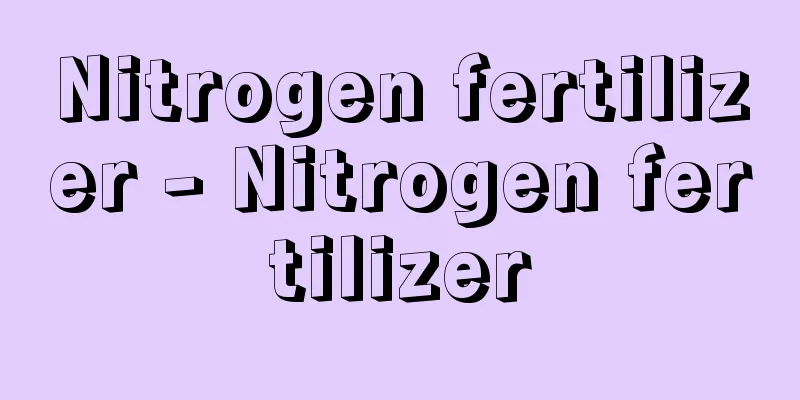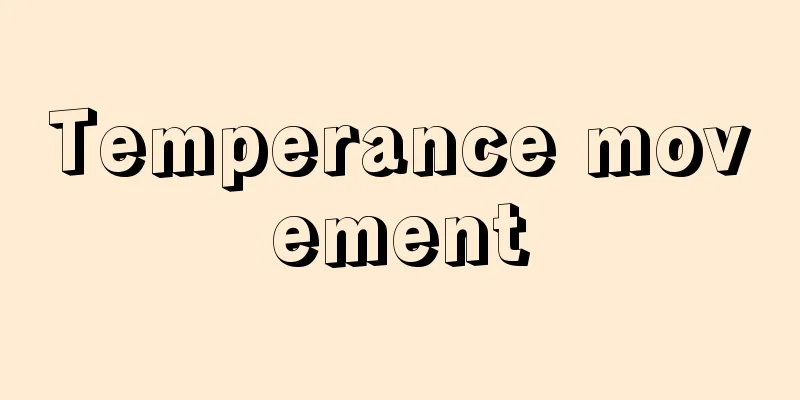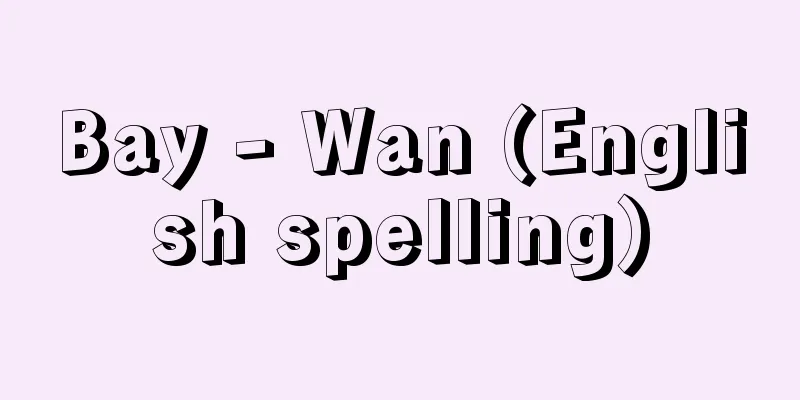Nitrogen fertilizer - Nitrogen fertilizer

|
A general term for fertilizers whose main component is nitrogen, one of the three major elements of fertilizer. Plants absorb and use nitrogen sources mainly in the form of ammonia and nitrate, so nitrogen fertilizers used are either in ammonia or nitrate form, or fertilizers that change to these forms in a short period of time after being applied to the soil. Nitrogen fertilizers currently used in Japan can be classified according to the form of nitrogen in the compound, into inorganic nitrates, ammonium salts, urea, cyanamide nitrogen fertilizers, and slow-release nitrogen fertilizers, and many organic fertilizers for plants and animals are also considered to be nitrogen fertilizers. [Yuki Koyama] NitratesThere are ammonium nitrate (ammonium nitrate) and sodium nitrate (Chilean saltpeter), both of which are water-soluble, fast-acting fertilizers. They are suitable as top dressing for field crops, but are difficult to adsorb into the soil and are easily washed away by rainwater. In paddy fields, they are also easily reduced to nitrogen gas and lost into the atmosphere, making them unsuitable for use on rice. They are highly hygroscopic, making them inconvenient to handle and store, so there is not much demand for them. [Yuki Koyama] Ammonium saltsAlthough it is water-soluble and fast-acting, it is well absorbed by the soil and does not easily wash away, and it is also not very hygroscopic, so it is the most commonly used. The main types include ammonium sulfate, ammonium chloride, and ammonium phosphate, and there are slight differences in fertilizer effectiveness depending on the anion. For example, ammonium sulfate is not suitable for aging paddy fields that are prone to fall in the fall, and ammonium chloride is not suitable for starchy crops such as potatoes. [Yuki Koyama] ureaAlthough it is an organic substance, its fertilizing effect is usually not much different from that of ammonium salts. Because the aqueous solution is not ionic, it is not easily adsorbed by the soil and is easily washed away by rainwater. However, after application, it changes to ammonium carbonate, which makes it more easily adsorbed by the soil. It has the advantage of being cheap per unit of nitrogen, physiologically neutral, and can also be used for foliar spraying. [Yuki Koyama] Cyanamide nitrogen fertilizerIt contains calcium nitrate, is alkaline, and its fertilizing effect is slightly slower than that of ammonium salts. It is toxic to living organisms, and this toxicity is used to control microorganisms and small animals, making it a unique fertilizer that also has pesticide effects. [Yuki Koyama] Slow-release nitrogen fertilizerNitrogen fertilizers developed to prevent fertilizer components from leaching include guanylurea (a salt obtained by hydrolyzing dicyandiamide in an acidic solution), ureaform (urea processed with formaldehyde), and IB (a mixture of urea and isobutyraldehyde). They decompose slowly in the soil to produce ammonia, so the nitrogen components are released slowly. The use of coated fertilizers, which make it easier to control fertilizer effectiveness, is increasing. [Yuki Koyama] Fertilizers containing protein nitrogenThere are fish fertilizers and oil cakes, which are organic and decomposed by microorganisms in the soil and converted into ammonia before being used by plants, making them slow-release fertilizers. Therefore, they do not cause concentration problems and are safe and easy to use with long-lasting fertilizer effects, and since they also contain ingredients such as phosphoric acid and potassium, they are mainly used for horticultural crops and perennial crops. Because they are expensive, they are not consumed in large quantities. In general, fertilizers tend to be used in combination, so their use as single fertilizers has decreased, but nitrogen fertilizers are also used as single fertilizers for top dressing. [Yuki Koyama] [Reference item] |Source: Shogakukan Encyclopedia Nipponica About Encyclopedia Nipponica Information | Legend |
|
肥料三要素の一つである窒素を主成分とする肥料の総称。植物は窒素源を主としてアンモニアと硝酸の形で吸収利用するので、窒素肥料もアンモニア態か硝酸態のもの、あるいは土壌に施用されたあとで短期間にこれらの形に変化するものが使用されている。現在、日本で使われている窒素肥料を窒素の化合形態によって分類すると、無機質の硝酸塩類、アンモニウム塩類、尿素、シアナミド態窒素肥料、緩効性窒素肥料があり、また動植物の有機質肥料にも窒素肥料とみられるものが多い。 [小山雄生] 硝酸塩類硝酸アンモニウム(硝安)、硝酸ソーダ(チリ硝石)などがあり、いずれも水溶性の速効性肥料である。畑作物の追肥用として好適であるが、土壌に吸着されにくく雨水で流されやすい。また水田では窒素ガスに還元されて大気中に失われやすいので、水稲に使用することは不利である。吸湿性が強く取扱いや貯蔵に不便であるため需要はあまり多くない。 [小山雄生] アンモニウム塩類水溶性で速効的であるが、土によく吸着されるので流亡しにくく、吸湿性もあまり大きくないのでもっともよく使われている。おもなものに硫安、塩安、リン安などがあり、陰イオンの違いによって肥効に多少の差がある。たとえば、硫安は秋落ちしやすい老朽化水田には向かず、塩安はいも類などデンプン質作物には向かない。 [小山雄生] 尿素有機物であるが肥効は通常の場合アンモニウム塩と大差がない。水溶液がイオンでないため土壌に吸着されにくく雨水で流されやすい。しかし施用後は炭酸アンモニウムに変わり、土に吸着されやすくなる。窒素当りの値段は安く、生理的にも中性で葉面散布にも使用できる利点がある。 [小山雄生] シアナミド態窒素肥料石灰窒素があり、アルカリ性で肥効はアンモニウム塩に比べすこし遅い。生物に有毒で、この毒性を利用して微生物や小動物を制御するのに使われるなど農薬効果をあわせもつ特徴のある肥料である。 [小山雄生] 緩効性窒素肥料肥料成分の流亡を防ぐため開発された窒素肥料でグアニル尿素(ジシアンジアミドを酸性溶液中で加水分解して得た塩)、ウレアホルム(ホルムアルデヒド加工尿素)、IB(尿素とイソブチルアルデヒドの混合物)などがある。土の中で分解してアンモニアを生成するのが遅く、窒素成分がゆっくりと効く。肥効をコントロールしやすいコーティング肥料(被覆肥料)の利用が増えている。 [小山雄生] タンパク態窒素を含む肥料魚肥、油かす類があり、有機質で土壌中で微生物によって分解されアンモニアに変化してから植物に利用されるので緩効的である。したがって濃度障害をおこさず、肥効が長続きする安全で使いやすい肥料であり、またリン酸やカリなどの成分もいっしょに含まれているので、おもに園芸作物や永年作物などに使われている。高価なため消費量はそれほど多くない。 全般に肥料は複合化されて使用される傾向にあるので、単肥としての使用は減っているが、窒素肥料は追肥用に単肥としても用いられる。 [小山雄生] [参照項目] |出典 小学館 日本大百科全書(ニッポニカ)日本大百科全書(ニッポニカ)について 情報 | 凡例 |
<<: Chittagong (English spelling)
>>: Nitrogen Determination Method
Recommend
Hair Drop Play - Kashiradareasobi
...The first day of the festival is called "...
Ridge Line - Onesen
...Then it rises northward over the Korean Penins...
Right of resistance
The right of an individual or group to resist pub...
Tokyo [City] - Tokyo
The capital of Japan. It is located almost in the ...
Akiyama
〘Noun〙 In the Edo period, the mountains under the ...
barrier
…Fourthly, a feature not only of Mexico but of La...
International politics
When we look at the relationship between nations ...
White clove (White clove) - White clove
An evergreen shrub of the Rubiaceae family native ...
Ohiroshiki-muki
…Even the buildings of Edo Castle, the residence ...
NS Savannah (English spelling) NSSavannah
…The Soviet Navy commissioned the nuclear cruiser...
Ebola haemorrhagic fever
…Of the three diseases, Lassa fever and Marburg d...
Music - Ongyoku
〘Noun〙① A general term for things played with musi...
Tosa Mitsunobu
Years of birth: Years of birth and death unknown. ...
Palladius, P. (English spelling) PalladiusP
…In the late Middle Ages (1350-1500), both sacred...
Japanese Romanticism
A literary magazine. It was published from March ...









